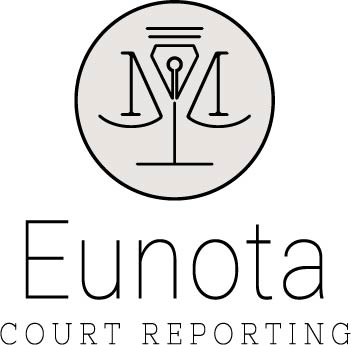Format & Transcript Style
Every client has unique transcript formatting needs. Eunota caters to those needs by offering a wide array of transcript styles and formats.
Eunota Court Reporting operates under the guidelines of the Department of Justice in New Brunswick for transcription formatting. We follow the same standard format that public sector court stenographers use to help keep legal documents consistent. Below is a general list of guidelines used for the preparation of transcripts:
Basic Format
All transcripts are produced using the New Brunswick Reference Guide for Private Sector Stenographers. This includes a transcript format of: title page, index page, legend, transcript, affidavit, and certificate. Transcripts are printed on 8.5″ x 11″ paper, with 2.08 spacing (23 lines) using the Courier New 12 point font. Questions are numbered (e.g., Q.134) and answers are marked as A.
Speaker Labels
At the beginning of a transcript, the names of speaking parties will be written (e.g., Mr. LEBLANC) if the judge is being addressed or if there is cross-talk. The judge is referred to as The Court. The transcript will follow a Q. and A. formatting for questioning between the examiner and respondent.
Standard Verbatim
As per provincial guidelines, the standard transcript will include mumbled words such as “mhm”, “mm mm”, etc., if they are an answer to a question. Mumbled words such as “eh” will also be included if it is used to pose a question. Repeated words such as stutters will be included – for example, “I — I went to the store.” Laughter and unconscious speech such as “ah” and “er” will not be included in the transcript.
Editing
Stenographers will not correct speaker’s grammar unless requested. Light editing may be included, for example excluding repeated words and stutters. Common slang such as, “you wanna” will be edited to, “you want to” for ease of reading. Where a speaker makes an obvious mistake (for example, giving the wrong year on an incident that is generally accepted as happening in a certain year), the stenographer will include the (sic) marking to note that there was an error. The following abbreviations are accepted in provincial guidelines: (ph) spelled phonetically, (no audible response) may be used if a speaker nods in agreement instead of verbalizing, ( – ) the dash is used to note a disruption in a thought or sentence, and (inaudible) denotes that the meaning of a portion of speech was not able to be discerned.
Numbers
Numbers are written in both numeral and written forms depending on the sentence. Dates, page numbers, and exhibit numbers always use numerals. The format will remain consistent throughout the transcript. Please contact us if you have a specific preference for numbers in your transcript.
Transcript Proofreading
All transcripts are proofread at least three times. Twice while transcription is undergoing – the stenographer pedals that we use allow us to rewind several seconds to re-read what we just typed to ensure accuracy. A third proofing of the entire document will catch any remaining small errors to ensure that your transcript is accurate and true to the recording.
Special Requests
If you need a transcript to be produced and have special requests above and beyond those outlined here, please get in touch with us. We would be happy to discuss your needs and tailor our transcription approach to help you meet your administrative needs. However, we are not able to change wording or meaning of the transcript in your favour. The integrity of the court reporting field relies on accurate portrayal of legal information. Small changes like omitting stutters or using a different format are okay.
